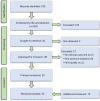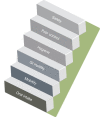Moving the needle: a narrative review of enhanced recovery protocols in breast reconstruction
- PMID: 38213812
- PMCID: PMC10777219
- DOI: 10.21037/atm-23-1509
Moving the needle: a narrative review of enhanced recovery protocols in breast reconstruction
Abstract
Background and objective: After a relatively late introduction to the literature in 2015, enhanced recovery protocols for breast reconstruction have flourished into a wealth of reports. Many have since described unique methodologies making improved offerings with superior outcomes attainable. This is a particularly interesting procedure for the study of enhanced recovery as it encompasses two dissident approaches. Compared to implant-based reconstruction, autologous free-flap reconstruction has demonstrated superiority in a range of long-term metrics at the expense of historically increased peri-operative morbidity. This narrative review collates reports of recovery protocols for both approaches and examines methodologies surrounding the key pieces of a comprehensive pathway.
Methods: All primary clinical reports specifically describing enhanced recovery protocols for implant-based and autologous breast reconstruction through 2022 were identified by systematic review of PubMed and Embase libraries. Twenty-five reports meeting criteria were identified, with ten additional reports included for narrative purpose. Included studies were examined for facets of innovation from the pre-hospital setting through outpatient follow-up. Notable findings were described in the context of a comprehensive framework with attention paid to clinical and basic scientific background. Considerations for implementation were additionally discussed.
Key content and findings: Of 35 included studies, 29 regarded autologous reconstruction with majority focus on reduction of peri-operative opioid requirements and length of stay. Six regarded implant-based reconstruction with most discussing pathways towards ambulatory procedures. Eighty percent of included studies were published after the 2017 consensus guidelines with many described innovations to this baseline. Pathways included considerations for pre-hospital, pre-operative, intra-operative, inpatient, and outpatient settings. Implant-based studies demonstrated that safe ambulatory care is accessible. Autologous studies demonstrated a trend towards discharge before post-operative day three and peri-operative opioid requirements equivalent to those of implant-based reconstructions.
Conclusions: Study of enhanced recovery after breast reconstruction has inspired paradigm shift and pushed limits previously not thought to be attainable. These protocols should encompass a longitudinal care pathway with optimization through patient-centered approaches and multidisciplinary collaboration. This framework should represent standard of care and will serve to expand availability of all methods of breast reconstruction.
Keywords: Enhanced recovery; breast reconstruction; enhanced recovery after surgery (ERAS); length of stay; outcomes.
2023 Annals of Translational Medicine. All rights reserved.
Conflict of interest statement
Conflicts of Interest: All authors have completed the ICMJE uniform disclosure form (available at https://atm.amegroups.com/article/view/10.21037/atm-23-1509/coif). The series “Breast Reconstruction” was commissioned by the editorial office without any funding or sponsorship. C.M.R. is a consultant for W.L Gore and Associates. A.G. serves on the board of directors of the American Board of Plastic Surgery, the California Society of Plastic Surgery, and the American Council of Academic Plastic Surgeons. The authors have no other conflicts of interest to declare.
Figures





Similar articles
-
Ambulatory latissimus dorsi flap breast reconstruction: A prospective cohort study of an enhanced recovery after surgery (ERAS) protocol.J Plast Reconstr Aesthet Surg. 2019 Dec;72(12):1950-1955. doi: 10.1016/j.bjps.2019.06.039. Epub 2019 Jul 17. J Plast Reconstr Aesthet Surg. 2019. PMID: 31488381
-
Enhanced recovery after surgery (ERAS) pathways in breast reconstruction: systematic review and meta-analysis of the literature.Breast Cancer Res Treat. 2019 Jan;173(1):65-77. doi: 10.1007/s10549-018-4991-8. Epub 2018 Oct 10. Breast Cancer Res Treat. 2019. PMID: 30306426
-
Enhanced Recovery after Surgery in Breast Reconstruction: A Systematic Review.J Reconstr Microsurg. 2019 Nov;35(9):695-704. doi: 10.1055/s-0039-1693699. Epub 2019 Aug 1. J Reconstr Microsurg. 2019. PMID: 31370092
-
Utility of ERAS Pathway in Nonabdominal-Based Microsurgical Breast Reconstruction: Efficacy in PAP Flap Reconstruction?J Reconstr Microsurg. 2022 Jun;38(5):371-377. doi: 10.1055/s-0041-1733993. Epub 2021 Aug 28. J Reconstr Microsurg. 2022. PMID: 34454407
-
Cost analysis of enhanced recovery after surgery in microvascular breast reconstruction.J Plast Reconstr Aesthet Surg. 2018 Jun;71(6):819-826. doi: 10.1016/j.bjps.2018.02.018. Epub 2018 Mar 2. J Plast Reconstr Aesthet Surg. 2018. PMID: 29606583
References
-
- Home [Internet]. ERAS® Society. [cited 2023 Mar 10]. Available online: https://erassociety.org/
Publication types
LinkOut - more resources
Full Text Sources
